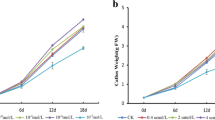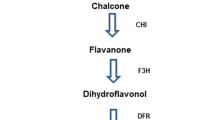Abstract
We have induced callus tissues from one R6/R6 homozygous genotype red-fleshed apple individual which was the hybrid offspring of Malus sieversii f.niedzwetzkyana and ‘Fuji’, and investigated the effect of auxin alone and auxin combined with cytokinin or nitrogen deficiency on anthocyanin synthesis. In callus culture, auxin alone significantly inhibited anthocyanin biosynthesis with the increase of auxin concentration. The inhibitory effect of 2,4-dichlorophenoxyacetic acid (2,4-D) on anthocyanin accumulation was about tenfold stronger than naphthalene acetic acid. Anthocyanin regulatory genes (MdMYB10 and MdbHLH3) and structural genes were dramatically suppressed by 0.6 mg/L 2,4-D. The inhibitory effect of auxin on anthocyanin biosynthesis was influenced by cytokinins 6-benzylaminopurine (BAP) and thidiazuron (TDZ) as well as nitrogen deficiency. Auxin and cytokinin displayed the interaction in controlling anthocyanin biosynthesis. Co-treatment of auxin and cytokinin (BAP or TDZ) significantly enhanced the cytokinin-induced increase in anthocyanin levels but too high auxin concentration strongly inhibited anthocyanin synthesis even in the presence of cytokinin. Nitrogen deficiency could reverse the inhibition of anthocyanin accumulation by auxin.








Similar content being viewed by others
Abbreviations
- 2, 4-D:
-
2, 4-Dichlorophenoxyacetic acid
- NAA:
-
Naphthalene acetic acid
- BAP:
-
6-Benzylaminopurine
- TDZ:
-
Thidiazuron
- MS:
-
Murashige and Skoog
References
Alfermann AW, Petersen M (1995) Natural product formation by plant cell biotechnology. Plant Cell Tissue Organ Cult 43:199–205
Allan AC, Hellens RP, Laing WA (2008) MYB transcription factors that colour our fruit. Trends Plant Sci 13:99–102
An XH, Tian Y, Chen KQ, Wang XF, Hao YJ (2012) The apple WD40 protein MdTTG1 interacts with bHLH but not MYB proteins to regulate anthocyanin accumulation. J Plant Physiol 169:710–717
Argyros RD, Mathews DE, Chiang YH, Palmer CM, Thibault DM, Etheridge N, Argyros DA, Mason MG, Kieber JJ, Schaller GE (2008) Type-B response regulators of Arabidopsis play key roles in cytokinin signalling and plant development. Plant Cell 20:2102–2116
Ban Y, Honda C, Hatsuyama Y, Igarashi M, Bessho H, Moriguchi T (2007) Isolation and functional analysis of a MYB transcription factor gene that is a key regulator for the development of red coloration in apple skin. Plant Cell Physiol 48:958–970
Bongue-Bartelsman M, Phillips DA (1995) Nitrogen stress regulates gene expression of enzymes in the flavonoid biosynthetic pathway of tomato. Plant Physiol Biochem 33:539–546
Brueggemann J, Weisshaar B, Sagasser M (2010) A WD40-repeat gene from Malus × domestica is a functional homologue of Arabidopsis thaliana TRANSPARENT TESTA GLABRA1. Plant Cell Rep 29:285–294
Butelli E, Titta L, Giorgio M, Mock HP, Matros A, Peterek S, Schijlen EGWM, Hall RD, Bovy AG, Luo J, Martin C (2008) Enrichment of tomato fruit with health-promoting anthocyanins by expression of select transcription factors. Nat Biotechnol 26:1301–1308
Chalker-Scott L (1999) Environmental significance of anthocyanins in plant stress responses. Photochem Photobiol 70:1–9
Chen XS, Feng T, Zhang YM, He TM, Feng JR, Zhang CY (2007) Genetic diversity of volatile components in Xinjiang wild apple (Malus sieversii). J Genet Genomics 34:171–179
Constabel F, Shyluk JP, Gamborg OL (1971) The effect of hormones on anthocyanin accumulation in cell cultures of Haplopappus gracilis. Planta 96:306–316
Das PK, Shin DH, Choi SB, Yoo SD, Choi G, Park YI (2012) Cytokinins enhance sugar-induced anthocyanin biosynthesis in Arabidopsis. Mol Cells 34:93–101
Deikman J, Hammer PE (1995) Induction of anthocyanin accumulation by cytokinins in Arabidopsis thaliana. Plant Physiol 108:47–57
Diaz C, Saliba-Colombani V, Loudet O, Belluomo P, Moreau L, Daniel-Vedele F, Morot-Gaudry JF, Masclaux-Daubresse C (2006) Leaf yellowing and anthocyanin accumulation are two genetically independent strategies in response to nitrogen limitation in Arabidopsis thaliana. Plant Cell Physiol 47:74–83
Do CB, Cormier F (1991) Effects of low nitrate and high sugar concentrations on anthocyanin content and composition of grape (Vitis vinifera L.) cell suspension. Plant Cell Rep 9:500–504
Dougall DK, Johnson JM, Whitten GH (1980) A clonal analysis of anthocyanin accumulation by cell cultures of wild carrot. Planta 149:292–297
Eberhardt MV, Lee CY, Liu RH (2000) Nutrition: antioxidant activity of fresh apples. Nature 405:903–904
Espley RV, Hellens RP, Putterill J, Stevenson DE, Kutty-Amma S, Allan AC (2007) Red colouration in apple fruit is due to the activity of the MYB transcription factor, MdMYB10. Plant J 49:414–427
Espley RV, Brendolise C, Chagné D et al (2009) Multiple repeats of a promoter segment causes transcription factor autoregulation in red apples. Plant Cell 21:168–183
Gonzalez A, Zhao M, Leavitt JM, Lloyd AM (2008) Regulation of the anthocyanin biosynthetic pathway by the TTG1/bHLH/Myb transcriptional complex in Arabidopsis seedlings. Plant J 53:814–827
Guo JC, Hu XW, Duan RJ (2005) Interactive effects of cytokinins, light and sucrose on the phenotypes and the syntheses of anthocyanins, lignins in cytokinin over-producing transgenic Arabidopsis. J Plant Growth Regul 24:93–101
Hirasun TJ, Shuler ML, Lackney VK, Spanswickc RM (1991) Enhanced anthocyanin production in grape cell cultures. Plant Sci 78:107–120
Honda C, Kotoda N, Wada M, Kondo S, Kobayashi S, Soejima J, Zhang Z, Tsuda T, Moriguchi T (2002) Anthocyanin biosynthetic genes are coordinately expressed during red coloration in apple skin. Plant Physiol Biochem 40:955–962
Ibrahim RK, Thakur ML, Permanand B (1971) Formation of anthocyanins in callus tissue cultures. Lloydia 34:175–182
Juliane W, Henryk F, Monika H, Andreas P, Mohammed AMSEA, Magda-Viola H (2014) Phenotypic and genetic analysis of the German Malus germplasm collection in terms of type 1 and type 2 red-fleshed apples. Gene 544:198–207
Kakegawa K, Suda J, Sugiyama M, Komamine A (1995) Regulation of anthocyanin biosynthesis in cell suspension cultures of Vitis in relation to cell division. Physiol Plant 94:661–666
Kim SH, Lee JR, Hong ST, Yoo YK, An G, Kim SR (2003) Molecular cloning and analysis of anthocyanin biosynthesis genes preferentially expressed in apple skin. Plant Sci 165:403–413
Koes R, Verweij W, Quattrocchio F (2005) Flavonoids; a colorful model for the regulation and evolution of biochemical pathways. Trends Plant Sci 10:236–242
Krisa S, Waffo Teguo P, Decendit A, Deffieux G, Vercauteren J, Merillon J-M (1999) Production of 13C-labelled anthocyanins by Vitis vinifera cell suspension cultures. Phytochemistry 51:651
Lea US, Slimestad R, Smedvig P, Lillo C (2007) Nitrogen deficiency enhances expression of specific MYB and bHLH transcription factors and accumulation of end products in the flavonoid pathway. Planta 225:1245–1253
Li YY, Mao K, Zhao C, Zhao XY, Zhang HL, Shu HR, Hao YJ (2012) MdCOP1 ubiquitin E3 ligases interact with MdMYB1 to regulate light-induced anthocyanin biosynthesis and red fruit coloration in apple. Plant Physiol 160:1011–1022
Livak KJ, Schmittgen TK (2001) Analysis of relative gene expression data using real-time quantitative PCR and the 2−ΔΔCt method. Methods 25:402–408
Matsumoto H, Nakamura Y, Tachibanaki S, Kawamura S, Hirayama M (2003) Stimulatory effect of cyanidin 3-glycosides on the regeneration of rhodopsin. J Agric Food Chem 51:3560–3563
Meyer HJ, Staden J (1995) The in vitro production of an anthocyanin from callus cultures of Oxalis linearis. Plant Cell Tissue Organ Cult 40:55–58
Mori T, Sakurai M (1994) Production of anthocyanin from strawberry cell suspension cultures; effects of sugar and nitrogen. J Food Sci 59:588–593
Murashige T, Skoog F (1962) A revised medium for rapid growth and bioassays with tobacco tissue cultures. Physiol Plant 15:473–497
Murthy HN, Lee EJ, Paek KY (2014) Production of secondary metabolites from cell and organ cultures: strategies and approaches for biomass improvement and metabolite accumulation. Plant Cell Tissue Organ Cult 118:1–16
Ozeki Y, Komamine A (1981) Induction of anthocyanin synthesis in relation to embryogenesis in a carrot suspension culture: correlation of metabolic differentiation with morphological differentiation. Physiol Plant 53:570–577
Ozeki Y, Komamine A (1985) Effects of inoculum density, zeatin and sucrose on anthocyanin accumulation in a carrot suspension culture. Plant Cell Tissue Organ Cult 5:45–53
Ozeki Y, Komamine A (1986) Effects of growth regulators on the induction of anthocyanin synthesis in carrot suspension cultures. Plant Cell Physiol 27:1361–1368
Peng MS, Hannam C, Gu HL, Bi YM, Rothstein SJ (2007) A mutation in NLA, which encodes a RING-type ubiquitin ligase, disrupts the adaptability of Arabidopsis to nitrogen limitation. Plant J 50:320–337
Rossi A, Serraino I, Dugo P, Di Paola R, Mondello L, Genovese T, Morabito D, Dugo G, Sautebin L, Caputi AP, Cuzzocrea S (2003) Protective effects of anthocyanins from blackberry in a rat model of acute lung inflammation. Free Radic Res 37(8):891–900
Rupasinghe HPV, Huber GM, Embree C, Forsline PL (2010) Red-fleshed apple as a source for functional beverages. Can J Plant Sci 90(1):95–100
Scheible WR, Morcuende R, Czechowski T, Fritz C, Osuna D, Palacios-Rojas N, Schindelasch D, Thimm O, Udvardi MK, Stitt M (2004) Genome-wide reprogramming of primary and secondary metabolism, protein synthesis, cellular growth processes, and the regulatory infrastructure of Arabidopsis in response to nitrogen. Plant Physiol 136:2483–2499
Sevimli-Gur C, Burcu C, Akay S, Gulce-Iz S, Yesil-Celiktas O (2013) Extracts from black carrot tissue culture as potent anticancer agents. Plant Foods Hum Nutr 68:293–298
Shin WH, Park SJ, Kim EJ (2006) Protective effect of anthocyanins in middle cerebral artery occlusion and reperfusion model of cerebral ischemia in rats. Life Sci 79:130–137
Smetanska I (2008) Production of secondary metabolites using plant cell cultures. Adv Biochem Eng Biotechnol 111:187–228
Stewart AJ, Chapman W, Jenkins GI, Graham I, Martin T, Crozier A (2001) The effect of nitrogen and phosphorus deficiency on flavonol accumulation in plant tissues. Plant Cell Environ 24:1189–1197
Takos AM, Jaffe´ FW, Jacob SR, Bogs J, Robinson SP, Walker AR (2006) Light-induced expression of a MYB gene regulates anthocyanin biosynthesis in red apples. Plant Physiol 142:1216–1232
Toufektsian MC et al (2008) Chronic dietary intake of plant-derived anthocyanins protects the rat heart against ischemia-reperfusion injury. J Nutr 138:747–752
Tsuda T, Horio F, Uchida K, Aoki H, Osawa T (2003) Dietary cyanidin 3-O-beta-D-glucoside-rich purple corn color prevents obesity and ameliorates hyperglycemia in mice. J Nutr 133:2125–2130
Velasco R, Zharkikh A, Affourtit J et al (2010) The genome of the domesticated apple (Malus × domestica Borkh.). Nat Genet 42:833–839
Winkel-Shirley B (2001) Flavonoid biosynthesis: a colorful model for genetics, biochemistry, cell biology, and biotechnology. Plant Physiol 126:485–493
Xie XB, Li S, Zhang RF, Zhao J, Chen YC, Zhao Q, Yao YX, You CX, Zhang XS, Hao YJ (2012) The bHLH transcription factor MdbHLH3 promotes anthocyanin accumulation and fruit colouration in response to low temperature in apples. Plant Cell Environ 35:1884–1897
Zhang XY, Chen XS, Peng Y, Wang HB, Shi J, Zhang H (2008a) Genetic diversity of mineral elements, sugar and acid components in Malus sieversii (Ldb.) Roem. Acta Hortic Sin 35:277–280 (in Chinese)
Zhang XY, Chen XS, Peng Y, Liu ZC, Shi J, Wang HB (2008b) Genetic diversity of phenolic compounds in Malus sieversii. Acta Hortic Sin 35:1351–1356 (in Chinese)
Zhang CY, Chen XS, Lin Q, Yuan ZH, Zhang H, Zhang XY, Liu CQ, Wu CJ (2009) SRAP markers for population genetic structure and genetic diversity in Malus sieversii from Xinjiang, China. Acta Hortic Sin 36:7–14 (in Chinese)
Zhou LL, Zeng HN, Shi MZ, Xie DY (2008) Development of tobacco callus cultures over expressing Arabidopsis PAP1/MYB75 transcription factor and characterization of anthocyanin biosynthesis. Planta 229:37–51
Acknowledgments
This work was supported by Special Fund for Agro-scientific Research in the Public Interest (201303093) and Natl. Natural Science Foundation of China (Grant Nos. 31171932 and 31201593).
Author information
Authors and Affiliations
Corresponding author
Electronic supplementary material
Below is the link to the electronic supplementary material.
Rights and permissions
About this article
Cite this article
Ji, XH., Wang, YT., Zhang, R. et al. Effect of auxin, cytokinin and nitrogen on anthocyanin biosynthesis in callus cultures of red-fleshed apple (Malus sieversii f.niedzwetzkyana). Plant Cell Tiss Organ Cult 120, 325–337 (2015). https://doi.org/10.1007/s11240-014-0609-y
Received:
Accepted:
Published:
Issue Date:
DOI: https://doi.org/10.1007/s11240-014-0609-y




